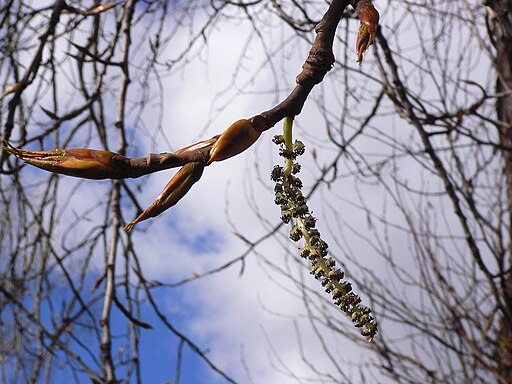Timberpedia - Poplar (Black Cottonwood / Western Balsam)
Poplar (Black Cottonwood / Western Balsam)
| Latin Name: | Irish Name: | Native to Ireland? |
|---|---|---|
| Populus trichocarpa | No |
About the Tree
Introduced 1892. Very susceptible to bacterial canker of the stem & branches.
Poplars are a genus of trees which includes the cottonwoods, poplars, and aspens, also known as
Populus or popple.
Many poplars are grown as ornamental trees, with numerous cultivars selected. They have the
advantage of growing very big very fast. Trees with fastigiate (erect, columnar) branching are
particularly popular, and very widely grown across Europe and southwest Asia in particular.
However, like willows, poplars have very vigorous and invasive root systems stretching up to 40 m
from the trees; planting close to houses or ceramic water pipes may result in damaged foundations
and cracked walls and pipes due to their search for moisture.
Black poplar, thought to be Britain’s most endangered native timber tree, has a wide, rounded
crown and dark grey fissured bark, with many swellings (‘bosses’) on the trunk. The deep green
leaves are roughly triangular or oval in shape and become yellow in autumn.
Other type of Poplar include White, Serotina.
About the Wood
Poplar was the most common wood used in Italy for panel paintings; the Mona Lisa and indeed
most famous Early Renaissance Italian paintings are on poplar.
Poplar is sometimes used in the bodies of electric guitars and drums.
The wood is generally white, often with a slightly yellowish cast.
It is also sold as inexpensive hardwood timber, used for pallets and cheap plywood; more specialised uses include matches and the boxes in which camembert cheese is sold. Poplar wood is
widely used in the snowboard industry for the snowboard “core”, because it has exceptional
flexibility.
Know your wood! The Timberpedia is a broad resource that aims to catalogue all the major tree species in Ireland, containing information that we’ve gathered from over two decades maintaining our natural woodland and serving Ireland’s woodworking industry.
All written material is copyright © 2021 by the Lisnavagh Timber Project.
Timberpedia
- Acacia
- Alder (Common)
- Apple
- Apple (Crab)
- Apple (Japanese Crab)
- Ash
- Aspen (Trembling Poplar)
- Beech
- Beech (Copper)
- Beech (Southern)
- Birch
- Box
- Cedar (Western Red)
- Cedar of Lebanon
- Cherry (Bird)
- Cherry (Wild) / Gean
- Chestnut (Horse)
- Chestnut (Sweet / Spanish)
- Cypress (Lawson)
- Cypress (Monterey)
- Elm (English)
- Elm (Wych)
- Eucalyptus
- Fir (Douglas)
- Fir (Grand/Giant)
- Fir (Noble)
- Fir (Silver/European)
- Hawthorn
- Hazel
- Holly
- Hornbeam
- Ivy
- Laburnum
- Larch (European)
- Larch (Japanese)
- Larch (Red)
- Laurel
- Lime
- Maidenhair Tree
- Maple (Field)
- Maple (Norway)
- Mimosa / Silver Wattle
- Monkey-Puzzle
- Musk (Olearia)
- Oak (Cork)
- Oak (Holm / Holly / Evergreen)
- Oak (Pedunculate / English)
- Oak (Red)
- Oak (Sessile / Irish)
- Oak (Turkey)
- Pear
- Pine
- Pine (Scots)
- Plane (London / Lacewood)
- Poplar (Black Cottonwood / Western Balsam)
- Poplar (Grey)
- Rowan (Mountain Ash)
- Spruce (Norway)
- Spruce (Sitka)
- Sycamore
- Tulip Tree
- Walnut (Black)
- Walnut (Common)
- Wellingtonia
- Western Hemlock
- Whitebeam
- Wild Service Tree
- Willow
- Willow (Bay)
- Willow (Crack)
- Willow (Cricket Bat)
- Willow (Goat / Sallow)
- Willow (White / Silver)
- Yew (English)
- Yew (Irish)




